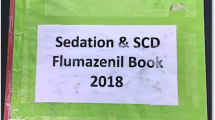Abstract
Background The National Patient Safety Agency (2008) has advised against routine reliance on flumazenil for reversal of sedation and encourages regular audit to help identify issues with excessive dosing of midazolam. This multi-centre audit of flumazenil use across both community-based special care and dental hospital oral surgery specialist services was conducted to compare practice against that reported from other UK sedation services.
Methods A six-year retrospective audit was conducted using controlled drug records and patient case notes.
Results Both services used flumazenil at very infrequent levels and far below the agreed standard. The dose of flumazenil and justification for its use was recorded in all records. There was variability in the nature of the justifications between the two services, which likely relates to the differing patient groups seen by the specialties. The majority of cases related to supporting the patient's escort for their journey home; however, this was not always pre-planned.
Conclusions There was a low level of flumazenil use over an extended period of time, supporting the concept of a culture of safe sedation provision in both services. The audit highlighted variation in record-keeping and need for improved communication with patients about escort requirements.
Key points
-
Highlights the importance of record-keeping of flumazenil use in dental sedation services.
-
Demonstrates the low levels of flumazenil prescribing in both a community and hospital setting.
-
Highlights the varying indications for flumazenil reversal of benzodiazepine-based dental sedation.
This is a preview of subscription content, access via your institution
Access options
Subscribe to this journal
Receive 24 print issues and online access
$259.00 per year
only $10.79 per issue
Buy this article
- Purchase on Springer Link
- Instant access to full article PDF
Prices may be subject to local taxes which are calculated during checkout


Similar content being viewed by others
References
Amrein R, Hetzel W. Pharmacology of Dormicum (midazolam) and Anexate (flumazenil). Acta Anaesthesiol Scand Suppl 1990; 92: 6-15; discussion 47.
National Patient Safety Agency. Rapid response report: Reducing risk of overdose with midazolam injection in adults. 2008. Available at https://www.sps.nhs.uk/wp-content/uploads/2018/02/2008-NRLS-1074A-midazolam-RRR-mation-2008-12-09-v1.pdf (accessed April 2021).
Intercollegiate Advisory Committee on Sedation in Dentistry. Standards for Conscious Sedation in the provision of Dental Care. 2015. Available online at https://www.rcseng.ac.uk/-/media/files/rcs/fds/publications/dental-sedation-report-2015-web-v2.pdf (accessed March 2020).
Scottish Dental Clinical Effectiveness Programme. Conscious Sedation in Dentistry. 2017. Available online at http://www.sdcep.org.uk/published-guidance/sedation/ (accessed March 2020).
UK Medicines Information. Q&A 178.4: How should dentists prescribe, store, order and dispose of controlled drugs? 2016. Available at https://www.sps.nhs.uk/wp-content/uploads/2016/06/NW-QA178.4-Controlled-drugs-for-dentists-1-1.pdf (accessed May 2020).
Girdler N M, Wilson K E, Booth E J. A prospective study of complications and outcomes associated with conscious sedation for the anxious dental patient. J Disabil Oral Health 2005; 6: 24-30.
Henthorn K M, Dickinson C. The use of flumazenil after midazolam-induced conscious sedation. Br Dent J 2010; 209: E18.
Ransford N J, Manley M C, Lewis D A et al. Intranasal/intravenous sedation for the dental care of adults with severe disabilities: a multicentre prospective audit. Br Dent J 2010; 208: 565-569.
Lewis D, Wray L, Sherborne M et al. The use of flumazenil for adults with learning disabilities undergoing conscious sedation with midazolam for dental treatment: a multicentre prospective audit. J Disabil Oral Health 2015; 16: 33-37.
Harrhy C R, Robb N D. The use of flumazenil in a community dental service - a service evaluation. SAAD Dig 2019; 35: 28-32.
General Dental Council. Standards for the Dental Team. 2013. Available online at https://standards.gdc-uk.org/ (accessed March 2020).
Folland L, Brown E, Boyle C. A review of the use of flumazenil for the reversal of midazolam conscious sedation in dentistry. SAAD Dig 2017; 33: 13-17.
Yonel Z, Asuni A, Taneja P. Defining over-sedation: literature review and national survey of dental hospitals within the United Kingdom. SAAD Dig 2016; 32: 28-33.
Greaves A. The use of midazolam as an intranasal sedative in dentistry. SAAD Dig 2016; 32: 46-49.
Moon Y E. Paradoxical reaction to midazolam in children. Korean J Anesthesiol 2013; 65: 2-3.
McKenzie W S, Rosenberg M. Paradoxical Reaction Following Administration of a Benzodiazepine. J Oral Maxillofac Surg 2010; 68: 3034-3036.
Cizmeci Senel F, Buchanan J M, Senel A C, Obeid G. Evaluation of Sedation Failure in the Outpatient Oral and Maxillofacial Surgery Clinic. J Oral Maxillofac Surg 2007; 65: 645-650.
Author information
Authors and Affiliations
Corresponding author
Ethics declarations
The authors declared no potential conflicts of interest with respect to the research, funding, authorship and/or publication of this article.
Rights and permissions
About this article
Cite this article
Wilson, C., Bird, J., Harrison, S. et al. Audit of flumazenil use in special care and oral surgery sedation services. Br Dent J (2021). https://doi.org/10.1038/s41415-021-3001-4
Received:
Accepted:
Published:
DOI: https://doi.org/10.1038/s41415-021-3001-4



